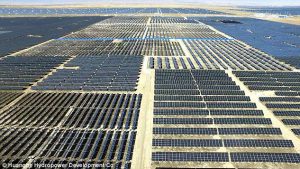Gonghe Solar Park covers an area of about 298 meters square. Experts have calculated that the whole park is five times larger than Manhattan. The uniqueness of the park is that 42 solar energy companies in China have created a single project. The power of the solar park is about 3500 megawatts. Gonghe Solar Park can provide 2.5 million households in remote areas. The new solar park is target at provincial areas located in the northern and western parts of China. These remote provinces make up almost a third of the state territory and are in extreme need of permanent energy supply.
 The solar park also includes a large research base of international scale. The staff of the base are collecting and analyzing information on the work of various models of solar panels that have been take from around the world. The analytical work is carry out with the help of the Fraunhofer Institute of Solar Energy Systems, which has the authority in the world scientific community.
The solar park also includes a large research base of international scale. The staff of the base are collecting and analyzing information on the work of various models of solar panels that have been take from around the world. The analytical work is carry out with the help of the Fraunhofer Institute of Solar Energy Systems, which has the authority in the world scientific community.
According to the representatives of the new solar park, the results of research will increase the efficiency of panels to the maximum possible mark and make the process of generating energy less costly from a financial point of view.
The project’s organizers emphasize that the solar park is capable of benefiting not only China, but the entire civilized world as a positive example of a global project for other states.
Gonghe Solar Park uses 21 kinds of inverter installations, 17 kinds of brackets, four types of energy storage devices, 15 innovative types of devices, and three dozen new connections in the form of a material base. These components make up 30 different system designs.
The Huanghe Hydropower Central Factory conducted a collection of 6.2 million solar polysilicon modules for the Gonghe Solar Park. The park was equipped with devices made in China, the United States and Germany. It is through this approach to the quality of equipment that one line does not require more than 15 workers.
For several years, China has been at the forefront of the solar power industry. The International Energy Agency last year said that China is focusing on one third of the world’s wind energy, a quarter of solar power. There are also 6 out of 10 largest solar module production companies and 4 out of 10 – for the manufacture of turbines for wind turbines.
One of the most striking examples of using alternative energy sources in remote areas is Qinghai Province. This region is capable of becoming the beginning of a revolutionary transition to the RES on a global scale.
 In the province, there are 3 of the 7 largest rivers of the state: Yellow River, Lancang and Yangtze. Hydropower plants are install on all three Tsinghai water resources. In addition, the province actively generates electricity with solar energy. The Qinghai-Tibet Mountain Plate allows you to gather enough energy that the province has 11 percent of the total solar potential of China.
In the province, there are 3 of the 7 largest rivers of the state: Yellow River, Lancang and Yangtze. Hydropower plants are install on all three Tsinghai water resources. In addition, the province actively generates electricity with solar energy. The Qinghai-Tibet Mountain Plate allows you to gather enough energy that the province has 11 percent of the total solar potential of China.
The Gobi Desert also plays an important role in generating electricity, as both its solar and wind parks find its place.
In May of this year, 86 percent of energy in Qinghai Province was obtain from REE. At the end of June, for 9 days the province and completely abandoned the energy from the general network. The region was provide with exclusively “green” energy for 216 hours.
Experts in the field of alternative energy from China note that the impetus of “green” energy submits the globe, country by country. China acts as an innovator to show the possible rapid increase in the share of renewable energy on the example of the provincial regions of the country.


